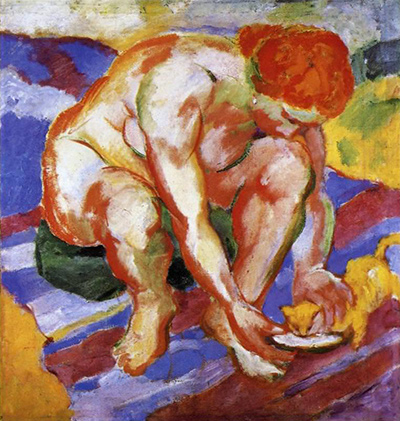In this oil painting we can see some of the first signs of Franz Mark's tendency towards subjective color selection. In Nude With Cat, we can definitely see the influence of the impressionists Henri Matisse (in the color palette) and Paul Cezanne (in the treatment of the figure).
It was during this period that Marc involved himself deeply in the study of color theory, and it's safe to say that Marc made some bold color choices in this painting. He covers the large surfaces with color in such a way that an unsettling effect is created, with many observers remarking the painting appears to be crumbling into pieces.
When reading this particular painting it's also wise to consider Franz Marc's codification of primary colors and their deeper spiritual meaning. For mark, yellow represented femininity, blue stood for masculinity, and red represented death.
When one is aware of the psychic force Marc believed that each primary color represented, "Nude with Cat" is seen in a whole new light, and is open to a myriad of new interpretations.
Although we can see that other artists did have an impact on Franz Marc, it would be wrong to interpret Marc as someone who copied the artists that he undoubtedly admired.
Instead, it would be more appropriate to see Marc's appropriation of different stylistic approaches as a means by which he was trying to represent his own internal world.
At the end of the day, "Nude with Cat' marks a pivotal point in Marc's transition from figurative forms, to expressionism, and then finally to outright abstraction. Marc painted "Nude with Cat" in 1910 at 30 years old. Six years later he would die as a German soldier on the battlefield in Verdun.
Despite having died in combat, Marcs' paintings were later deemed obscene by the Nazi regime, and their public display was prohibited until after world war II. Today this painting is housed at the Städtische Galerie im Lenbachhaus in Munich.




